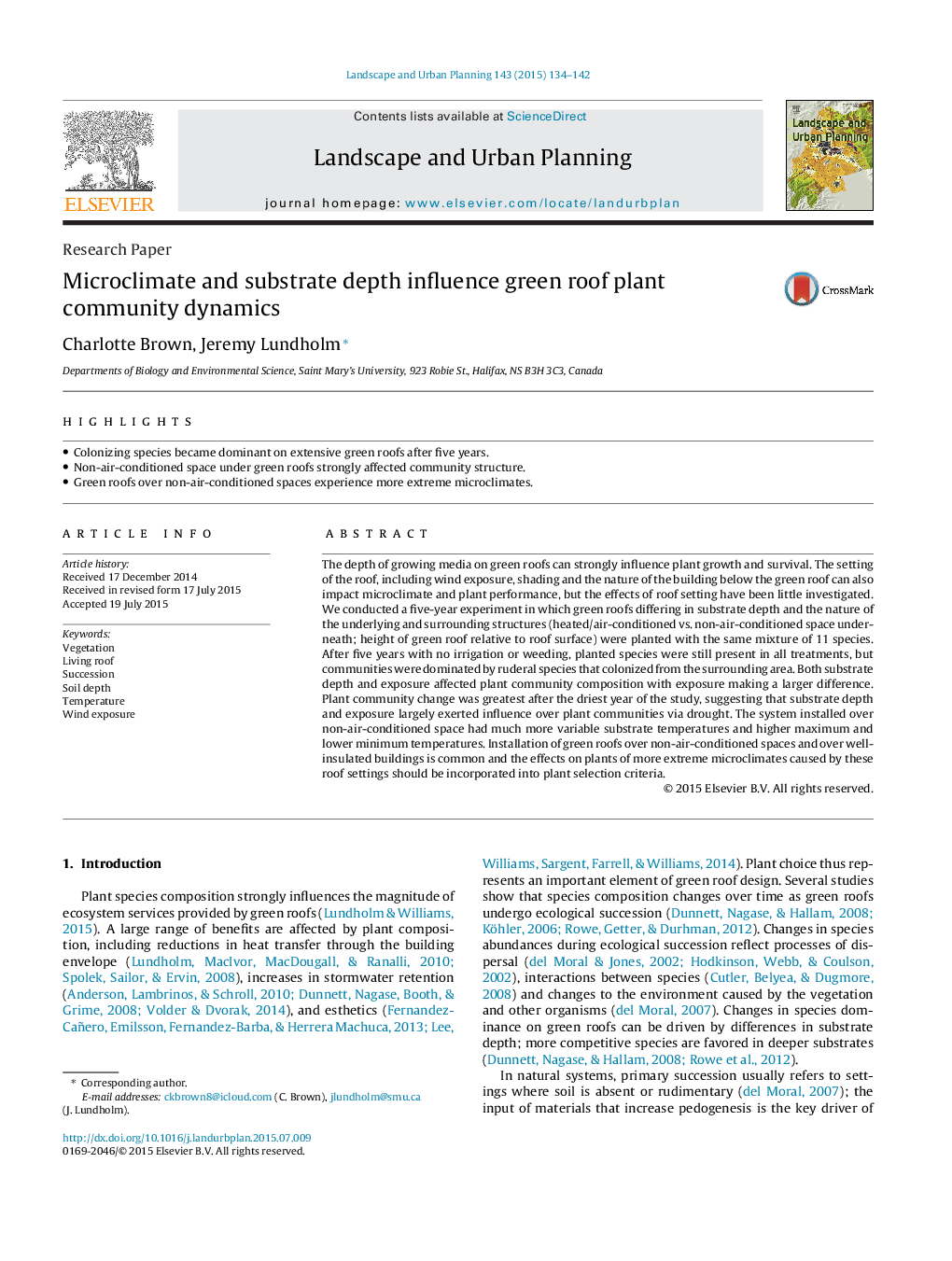| کد مقاله | کد نشریه | سال انتشار | مقاله انگلیسی | نسخه تمام متن |
|---|---|---|---|---|
| 7461005 | 1484615 | 2015 | 9 صفحه PDF | دانلود رایگان |
عنوان انگلیسی مقاله ISI
Microclimate and substrate depth influence green roof plant community dynamics
ترجمه فارسی عنوان
عمق میکرو کلم و غلظت بستر سبز گیاه سقف سبز
دانلود مقاله + سفارش ترجمه
دانلود مقاله ISI انگلیسی
رایگان برای ایرانیان
کلمات کلیدی
زندگی گیاهی، سقف زندگی، جانشینی، عمق خاک، درجه حرارت، قرار گرفتن در معرض باد،
ترجمه چکیده
عمق رسانه های رو به رشد در سقف های سبز می تواند به شدت بر رشد و بقاء گیاه تاثیر گذارد. تنظیم سقف، از جمله قرار گرفتن در معرض باد، سایه زدن و ماهیت ساختمان در زیر سقف سبز، می تواند بر سلامت محیط و عملکرد کارخانه تأثیر بگذارد، اما تأثیر تنظیم سقف کمی مورد بررسی قرار نگرفته است. ما یک آزمایش پنج ساله انجام دادیم که در آن سقفهای سبز متفاوت در عمق زیربنایی و ماهیت سازه های زیرین و اطراف (گرما / تهویه مطبوع در مقابل فضای غیر هوازیشده زیر، ارتفاع سقف سبز نسبت به سطح سقف) با همان ترکیب 11 گونه کاشته شده است. پس از پنج سال بدون آبیاری و یا علف هرز، گونه های کاشته شده هنوز در تمام تداخل وجود داشت، اما جوامع تحت تاثیر گونه های روده ای قرار گرفتند که از منطقه اطراف آن مستعمره شده بودند. هر دو عمق سوسپانسیون و قرار گرفتن در معرض ترکیب ترکیب گیاه جامعه با قرار گرفتن در معرض ایجاد تفاوت بزرگتر. تغییرات جمعیت گیاهی بعد از خشکی سال مطالعه بیشتر بود و نشانگر این بود که عمق سوسپانسیون و تاثیر آن بر جوامع گیاهی از طریق خشکسال تاثیر زیادی دارند. سیستم نصب شده بر روی فضای غیر هوشیار دارای تغییرات دمای زیربنای متغیر و حداکثر و حداقل دمای پایین بالاتر بود. نصب سقف های سبز بیش از فضاهای غیر هوازدگی و بیش از ساختمان های عایق بندی شده معمول است و تأثیر آن بر روی گیاهان میکروسکوپهای شدیدتر ناشی از این تنظیمات سقف باید در معیارهای انتخاب گیاه قرار گیرد.
موضوعات مرتبط
علوم زیستی و بیوفناوری
علوم کشاورزی و بیولوژیک
بوم شناسی، تکامل، رفتار و سامانه شناسی
چکیده انگلیسی
The depth of growing media on green roofs can strongly influence plant growth and survival. The setting of the roof, including wind exposure, shading and the nature of the building below the green roof can also impact microclimate and plant performance, but the effects of roof setting have been little investigated. We conducted a five-year experiment in which green roofs differing in substrate depth and the nature of the underlying and surrounding structures (heated/air-conditioned vs. non-air-conditioned space underneath; height of green roof relative to roof surface) were planted with the same mixture of 11 species. After five years with no irrigation or weeding, planted species were still present in all treatments, but communities were dominated by ruderal species that colonized from the surrounding area. Both substrate depth and exposure affected plant community composition with exposure making a larger difference. Plant community change was greatest after the driest year of the study, suggesting that substrate depth and exposure largely exerted influence over plant communities via drought. The system installed over non-air-conditioned space had much more variable substrate temperatures and higher maximum and lower minimum temperatures. Installation of green roofs over non-air-conditioned spaces and over well-insulated buildings is common and the effects on plants of more extreme microclimates caused by these roof settings should be incorporated into plant selection criteria.
ناشر
Database: Elsevier - ScienceDirect (ساینس دایرکت)
Journal: Landscape and Urban Planning - Volume 143, November 2015, Pages 134-142
Journal: Landscape and Urban Planning - Volume 143, November 2015, Pages 134-142
نویسندگان
Charlotte Brown, Jeremy Lundholm,
